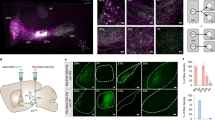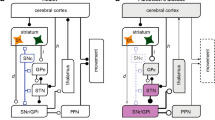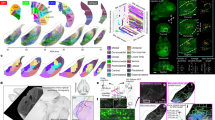Abstract
The basal ganglia are subcortical nuclei controlling voluntary actions and have been implicated in Parkinson's disease (PD). The prevailing model of basal ganglia function states that two circuits, the direct and indirect pathways, originate from distinct populations of striatal medium spiny neurons (MSNs) and project to different output structures. These circuits are believed to have opposite effects on movement. Specifically, the activity of direct pathway MSNs is postulated to promote movement, whereas the activation of indirect pathway MSNs is hypothesized to inhibit it. Recent findings have revealed that this model might not fully account for the concurrent activation of both pathways during movement. Accordingly, we propose a model in which intrastriatal connections are critical and the two pathways are structurally and functionally intertwined. Thus, all MSNs might either facilitate or inhibit movement depending on the form of synaptic plasticity expressed at a certain moment. In PD, alterations of dopamine-dependent synaptic plasticity could alter this coordinated activity.
This is a preview of subscription content, access via your institution
Access options
Subscribe to this journal
Receive 12 print issues and online access
$209.00 per year
only $17.42 per issue
Buy this article
- Purchase on Springer Link
- Instant access to full article PDF
Prices may be subject to local taxes which are calculated during checkout

Kim Caesar/Nature Publishing Group

Kim Caesar/Nature Publishing Group

Kim Caesar/Nature Publishing Group

Kim Caesar/Nature Publishing Group
Similar content being viewed by others
References
Seneca, L.A. Moral letters to Lucilius (Epistulae morales ad Lucilium): a Loeb Classical Library edition, Vol. 1 (ed. Gummere, R.M.) (W. Heinemann, 1917).
DiFiglia, M., Pasik, P. & Pasik, T. A Golgi study of neuronal types in the neostriatum of monkeys. Brain Res. 114, 245–256 (1976).
Dubé, L., Smith, A.D. & Bolam, J.P. Identification of synaptic terminals of thalamic or cortical origin in contact with distinct medium-size spiny neurons in the rat neostriatum. J. Comp. Neurol. 267, 455–471 (1988).
Lapper, S.R. & Bolam, J.P. Input from the frontal cortex and the parafascicular nucleus to cholinergic interneurons in the dorsal striatum of the rat. Neuroscience 51, 533–545 (1992).
Pickel, V.M., Chan, J. & Sesack, S.R. Cellular basis for interactions between catecholaminergic afferents and neurons containing Leu-enkephalin-like immunoreactivity in rat caudate-putamen nuclei. J. Neurosci. Res. 31, 212–230 (1992).
Bouyer, J.J., Park, D.H., Joh, T.H. & Pickel, V.M. Chemical and structural analysis of the relation between cortical inputs and tyrosine hydroxylase-containing terminals in rat neostriatum. Brain Res. 302, 267–275 (1984).
Kawaguchi, Y., Wilson, C.J., Augood, S.J. & Emson, P.C. Striatal interneurones: chemical, physiological and morphological characterization. Trends Neurosci. 18, 527–535 (1995).
Albin, R.L., Young, A.B. & Penney, J.B. The functional anatomy of basal ganglia disorders. Trends Neurosci. 12, 366–375 (1989).
DeLong, M.R. Primate models of movement disorders of basal ganglia origin. Trends Neurosci. 13, 281–285 (1990).
Gerfen, C.R. et al. D1 and D2 dopamine receptor–regulated gene expression of striatonigral and striatopallidal neurons. Science 250, 1429–1432 (1990).
Gerfen, C.R. & Surmeier, D.J. Modulation of striatal projection systems by dopamine. Annu. Rev. Neurosci. 34, 441–466 (2011).
Bateup, H.S. et al. Distinct subclasses of medium spiny neurons differentially regulate striatal motor behaviors. Proc. Natl. Acad. Sci. USA 107, 14845–14850 (2010).
Valjent, E., Bertran-Gonzalez, J., Herve, D., Fisone, G. & Girault, J.A. Looking BAC at striatal signaling: cell-specific analysis in new transgenic mice. Trends Neurosci. 32, 538–547 (2009).
Kawaguchi, Y., Wilson, C.J. & Emson, P.C. Intracellular recording of identified neostriatal patch and matrix spiny cells in a slice preparation preserving cortical inputs. J. Neurophysiol. 62, 1052–1068 (1989).
Cepeda, C. et al. Differential electrophysiological properties of dopamine D1 and D2 receptor–containing striatal medium-sized spiny neurons. Eur. J. Neurosci. 27, 671–682 (2008).
Kreitzer, A.C. & Malenka, R.C. Endocannabinoid-mediated rescue of striatal LTD and motor deficits in Parkinson's disease models. Nature 445, 643–647 (2007).
Day, M., Wokosin, D., Plotkin, J.L., Tian, X. & Surmeier, D.J. Differential excitability and modulation of striatal medium spiny neuron dendrites. J. Neurosci. 28, 11603–11614 (2008).
Gertler, T.S., Chan, C.S. & Surmeier, D.J. Dichotomous anatomical properties of adult striatal medium spiny neurons. J. Neurosci. 28, 10814–10824 (2008).
Day, M. et al. Selective elimination of glutamatergic synapses on striatopallidal neurons in Parkinson disease models. Nat. Neurosci. 9, 251–259 (2006).
Calabresi, P. et al. Dopamine and cAMP-regulated phosphoprotein 32 kDa controls both striatal long-term depression and long-term potentiation, opposing forms of synaptic plasticity. J. Neurosci. 20, 8443–8451 (2000).
Calabresi, P., Maj, R., Mercuri, N.B. & Bernardi, G. Coactivation of D1 and D2 dopamine receptors is required for long-term synaptic depression in the striatum. Neurosci. Lett. 142, 95–99 (1992).
Calabresi, P., Maj, R., Pisani, A., Mercuri, N.B. & Bernardi, G. Long-term synaptic depression in the striatum: physiological and pharmacological characterization. J. Neurosci. 12, 4224–4233 (1992).
Lovinger, D.M., Tyler, E.C. & Merritt, A. Short- and long-term synaptic depression in rat neostriatum. J. Neurophysiol. 70, 1937–1949 (1993).
Shen, W., Flajolet, M., Greengard, P. & Surmeier, D.J. Dichotomous dopaminergic control of striatal synaptic plasticity. Science 321, 848–851 (2008).
Kravitz, A.V. et al. Regulation of parkinsonian motor behaviours by optogenetic control of basal ganglia circuitry. Nature 466, 622–626 (2010).
Hikosaka, O., Nakamura, K. & Nakahara, H. Basal ganglia orient eyes to reward. J. Neurophysiol. 95, 567–584 (2006).
Redgrave, P. et al. Goal-directed and habitual control in the basal ganglia: implications for Parkinson's disease. Nat. Rev. Neurosci. 11, 760–772 (2010).
Tai, L.H., Lee, A.M., Benavidez, N., Bonci, A. & Wilbrecht, L. Transient stimulation of distinct subpopulations of striatal neurons mimics changes in action value. Nat. Neurosci. 15, 1281–1289 (2012).
Eshel, N. & Roiser, J.P. Reward and punishment processing in depression. Biol. Psychiatry 68, 118–124 (2010).
Koob, G.F. & Volkow, N.D. Neurocircuitry of addiction. Neuropsychopharmacology 35, 217–238 (2010).
Kravitz, A.V., Tye, L.D. & Kreitzer, A.C. Distinct roles for direct and indirect pathway striatal neurons in reinforcement. Nat. Neurosci. 15, 816–818 (2012).
Hikida, T., Kimura, K., Wada, N., Funabiki, K. & Nakanishi, S. Distinct roles of synaptic transmission in direct and indirect striatal pathways to reward and aversive behavior. Neuron 66, 896–907 (2010).
Ferguson, S.M. et al. Transient neuronal inhibition reveals opposing roles of indirect and direct pathways in sensitization. Nat. Neurosci. 14, 22–24 (2011).
Voon, V. et al. Chronic dopaminergic stimulation in Parkinson's disease: from dyskinesias to impulse control disorders. Lancet Neurol. 8, 1140–1149 (2009).
Vitek, J.L. et al. Randomized trial of pallidotomy versus medical therapy for Parkinson's disease. Ann. Neurol. 53, 558–569 (2003).
Alvarez, L. et al. Bilateral subthalamotomy in Parkinson's disease: initial and long-term response. Brain 128, 570–583 (2005).
Fasano, A., Daniele, A. & Albanese, A. Treatment of motor and non-motor features of Parkinson's disease with deep brain stimulation. Lancet Neurol. 11, 429–442 (2012).
Odekerken, V.J. et al. Subthalamic nucleus versus globus pallidus bilateral deep brain stimulation for advanced Parkinson's disease (NSTAPS study): a randomized controlled trial. Lancet Neurol. 12, 37–44 (2013).
Schuepbach, W.M. et al. Neurostimulation for Parkinson's disease with early motor complications. N. Engl. J. Med. 368, 610–622 (2013).
Krack, P., Hariz, M.I., Baunez, C., Guridi, J. & Obeso, J.A. Deep brain stimulation: from neurology to psychiatry? Trends Neurosci. 33, 474–484 (2010).
Vonsattel, J.P. et al. Neuropathological classification of Huntington's disease. J. Neuropathol. Exp. Neurol. 44, 559–577 (1985).
André, V.M. et al. Differential electrophysiological changes in striatal output neurons in Huntington's disease. J. Neurosci. 31, 1170–1182 (2011).
Freeze, B.S., Kravitz, A.V., Hammack, N., Berke, J.D. & Kreitzer, A.C. Control of basal ganglia output by direct and indirect pathway projection neurons. J. Neurosci. 33, 18531–18539 (2013).
Cui, G. et al. Concurrent activation of striatal direct and indirect pathways during action initiation. Nature 494, 238–242 (2013).
Durieux, P.F. et al. D2R striatopallidal neurons inhibit both locomotor and drug reward processes. Nat. Neurosci. 12, 393–395 (2009).
Kress, G.J. et al. Convergent cortical innervation of striatal projection neurons. Nat. Neurosci. 16, 665–667 (2013).
Kramer, P.F. et al. Dopamine D2 receptor overexpression alters behavior and physiology in Drd2-EGFP mice. J. Neurosci. 31, 126–132 (2011).
Bagetta, V. et al. Dopamine-dependent long-term depression is expressed in striatal spiny neurons of both direct and indirect pathways: implications for Parkinson's disease. J. Neurosci. 31, 12513–12522 (2011).
Deng, Y.P., Lei, W.L. & Reiner, A. Differential perikaryal localization in rats of D1 and D2 dopamine receptors on striatal projection neuron types identified by retrograde labeling. J. Chem. Neuroanat. 32, 101–116 (2006).
Chan, C.S. et al. Strain-specific regulation of striatal phenotype in Drd2-eGFP BAC transgenic mice. J. Neurosci. 32, 9124–9132 (2012).
Nelson, A.B. et al. A comparison of striatal-dependent behaviors in wild-type and hemizygous Drd1a and Drd2 BAC transgenic mice. J. Neurosci. 32, 9119–9123 (2012).
Cazorla, M. et al. Dopamine D2 receptors regulate the anatomical and functional balance of basal ganglia circuitry. Neuron 81, 153–164 (2014).
Kawaguchi, Y., Wilson, C.J. & Emson, P.C. Projection subtypes of rat neostriatal matrix cells revealed by intracellular injection of biocytin. J. Neurosci. 10, 3421–3438 (1990).
Lévesque, M. & Parent, A. The striatofugal fiber system in primates: a reevaluation of its organization based on single-axon tracing studies. Proc. Natl. Acad. Sci. USA 102, 11888–11893 (2005).
Parent, A., Charara, A. & Pinault, D. Single striatofugal axons arborizing in both pallidal segments and in the substantia nigra in primates. Brain Res. 698, 280–284 (1995).
Nadjar, A. et al. Phenotype of striatofugal medium spiny neurons in parkinsonian and dyskinetic nonhuman primates: a call for a reappraisal of the functional organization of the basal ganglia. J. Neurosci. 26, 8653–8661 (2006).
Hasbi, A. et al. Calcium signaling cascade links dopamine D1–D2 receptor heteromer to striatal BDNF production and neuronal growth. Proc. Natl. Acad. Sci. USA 106, 21377–21382 (2009).
Perreault, M.L., Hasbi, A., O'Dowd, B.F. & George, S.R. Heteromeric dopamine receptor signaling complexes: emerging neurobiology and disease relevance. Neuropsychopharmacology 39, 156–168 (2013).
Calabresi, P., Picconi, B., Tozzi, A. & Di Filippo, M. Dopamine-mediated regulation of corticostriatal synaptic plasticity. Trends Neurosci. 30, 211–219 (2007).
Jia, Y., Gall, C.M. & Lynch, G. Presynaptic BDNF promotes postsynaptic long-term potentiation in the dorsal striatum. J. Neurosci. 30, 14440–14445 (2010).
Lovinger, D.M. Neurotransmitter roles in synaptic modulation, plasticity and learning in the dorsal striatum. Neuropharmacology 58, 951–961 (2010).
Calabresi, P., Di Filippo, M., Ghiglieri, V., Tambasco, N. & Picconi, B. Levodopa-induced dyskinesias in patients with Parkinson's disease: filling the bench-to-bedside gap. Lancet Neurol. 9, 1106–1117 (2010).
Russo, S.J., Mazei-Robison, M.S., Ables, J.L. & Nestler, E.J. Neurotrophic factors and structural plasticity in addiction. Neuropharmacology 56 (suppl. 1) 73–82 (2009).
Adermark, L., Talani, G. & Lovinger, D.M. Endocannabinoid-dependent plasticity at GABAergic and glutamatergic synapses in the striatum is regulated by synaptic activity. Eur. J. Neurosci. 29, 32–41 (2009).
Gerdeman, G.L., Ronesi, J. & Lovinger, D.M. Postsynaptic endocannabinoid release is critical to long-term depression in the striatum. Nat. Neurosci. 5, 446–451 (2002).
Mathur, B.N. & Lovinger, D.M. Endocannabinoid-dopamine interactions in striatal synaptic plasticity. Front Pharmacol 3, 66 (2012).
Adermark, L. & Lovinger, D.M. Retrograde endocannabinoid signaling at striatal synapses requires a regulated postsynaptic release step. Proc. Natl. Acad. Sci. USA 104, 20564–20569 (2007).
Yin, H.H. & Lovinger, D.M. Frequency-specific and D2 receptor–mediated inhibition of glutamate release by retrograde endocannabinoid signaling. Proc. Natl. Acad. Sci. USA 103, 8251–8256 (2006).
Ronesi, J., Gerdeman, G.L. & Lovinger, D.M. Disruption of endocannabinoid release and striatal long-term depression by postsynaptic blockade of endocannabinoid membrane transport. J. Neurosci. 24, 1673–1679 (2004).
Wang, Z. et al. Dopaminergic control of corticostriatal long-term synaptic depression in medium spiny neurons is mediated by cholinergic interneurons. Neuron 50, 443–452 (2006).
Tozzi, A. et al. The distinct role of medium spiny neurons and cholinergic interneurons in the D2/A2A receptor interaction in the striatum: implications for Parkinson's disease. J. Neurosci. 31, 1850–1862 (2011).
Di Filippo, M. et al. The endocannabinoid system in Parkinson's disease. Curr. Pharm. Des. 14, 2337–2347 (2008).
Pisani, V. et al. Homeostatic changes of the endocannabinoid system in Parkinson's disease. Mov. Disord. 26, 216–222 (2011).
Gubellini, P. et al. Experimental parkinsonism alters endocannabinoid degradation: implications for striatal glutamatergic transmission. J. Neurosci. 22, 6900–6907 (2002).
Maccarrone, M. et al. Levodopa treatment reverses endocannabinoid system abnormalities in experimental parkinsonism. J. Neurochem. 85, 1018–1025 (2003).
Gerdeman, G.L., Partridge, J.G., Lupica, C.R. & Lovinger, D.M. It could be habit forming: drugs of abuse and striatal synaptic plasticity. Trends Neurosci. 26, 184–192 (2003).
Nazzaro, C. et al. SK channel modulation rescues striatal plasticity and control over habit in cannabinoid tolerance. Nat. Neurosci. 15, 284–293 (2012).
Vincent, S.R. Nitric oxide neurons and neurotransmission. Prog. Neurobiol. 90, 246–255 (2010).
Fino, E. & Venance, L. Spike-timing dependent plasticity in striatal interneurons. Neuropharmacology 60, 780–788 (2011).
West, A.R. & Tseng, K.Y. Nitric oxide–soluble guanylyl cyclase–cyclic GMP signaling in the striatum: new targets for the treatment of Parkinson's disease? Front. Syst. Neurosci. 5, 55 (2011).
Calabresi, P. et al. A critical role of the nitric oxide/cGMP pathway in corticostriatal long-term depression. J. Neurosci. 19, 2489–2499 (1999).
Picconi, B. et al. Inhibition of phosphodiesterases rescues striatal long-term depression and reduces levodopa-induced dyskinesia. Brain 134, 375–387 (2011).
Arcangeli, S. et al. Ischemic-LTP in striatal spiny neurons of both direct and indirect pathway requires the activation of D1-like receptors and NO/soluble guanylate cyclase/cGMP transmission. J. Cereb. Blood Flow Metab. 33, 278–286 (2013).
Aziz, T.Z., Peggs, D., Sambrook, M.A. & Crossman, A.R. Lesion of the subthalamic nucleus for the alleviation of 1-methyl-4-phenyl-1,2,3,6-tetrahydropyridine (MPTP)-induced parkinsonism in the primate. Mov. Disord. 6, 288–292 (1991).
Bergman, H., Wichmann, T. & DeLong, M.R. Reversal of experimental parkinsonism by lesions of the subthalamic nucleus. Science 249, 1436–1438 (1990).
Lang, A.E. et al. Posteroventral medial pallidotomy in advanced Parkinson's disease. N. Engl. J. Med. 337, 1036–1042 (1997).
Levy, R. et al. Effects of apomorphine on subthalamic nucleus and globus pallidus internus neurons in patients with Parkinson's disease. J. Neurophysiol. 86, 249–260 (2001).
Lewitt, P.A. Levodopa for the treatment of Parkinson's disease. N. Engl. J. Med. 359, 2468–2476 (2008).
Jenner, P. Molecular mechanisms of L-DOPA-induced dyskinesia. Nat. Rev. Neurosci. 9, 665–677 (2008).
Mercuri, N.B. & Bernardi, G. The 'magic' of L-dopa: why is it the gold standard Parkinson's disease therapy? Trends Pharmacol. Sci. 26, 341–344 (2005).
Perez-Lloret, S. & Rascol, O. Dopamine receptor agonists for the treatment of early or advanced Parkinson's disease. CNS Drugs 24, 941–968 (2010).
Bagetta, V. et al. Rebalance of striatal NMDA/AMPA receptor ratio underlies the reduced emergence of dyskinesia during D2-like dopamine agonist treatment in experimental Parkinson's disease. J. Neurosci. 32, 17921–17931 (2012).
Connolly, B.S. & Fox, S.H. Drug treatments for the neuropsychiatric complications of Parkinson's disease. Expert Rev. Neurother. 12, 1439–1449 (2012).
Toy, W.A. et al. Treadmill exercise reverses dendritic spine loss in direct and indirect striatal medium spiny neurons in the 1-methyl-4-phenyl-1,2,3,6-tetrahydropyridine (MPTP) mouse model of Parkinson's disease. Neurobiol. Dis. 63, 201–209 (2014).
Costa, R.M. et al. Rapid alterations in corticostriatal ensemble coordination during acute dopamine-dependent motor dysfunction. Neuron 52, 359–369 (2006).
Hammond, C., Bergman, H. & Brown, P. Pathological synchronization in Parkinson's disease: networks, models and treatments. Trends Neurosci. 30, 357–364 (2007).
Kasanetz, F., Riquelme, L.A., Della-Maggiore, V., O'Donnell, P. & Murer, M.G. Functional integration across a gradient of corticostriatal channels controls UP state transitions in the dorsal striatum. Proc. Natl. Acad. Sci. USA 105, 8124–8129 (2008).
Zold, C.L., Escande, M.V., Pomata, P.E., Riquelme, L.A. & Murer, M.G. Striatal NMDA receptors gate cortico-pallidal synchronization in a rat model of Parkinson's disease. Neurobiol. Dis. 47, 38–48 (2012).
Jin, X. & Costa, R.M. Start/stop signals emerge in nigrostriatal circuits during sequence learning. Nature 466, 457–462 (2010).
Calabresi, P. & Di Filippo, M. Neuroscience: brain's traffic lights. Nature 466, 449 (2010).
Acknowledgements
We thank A. Pisani for reading the manuscript and for critical discussion. This work was supported by Progetto di Ricerca di Interesse Nazionale (PRIN) 2011 2010AHHP5H (to P.C.) and Progetto del Ministero della Salute, Giovani Ricercatori (GR-2008-1142336 to B.P.; GR-2010-2316671 to V.G.).
Author information
Authors and Affiliations
Corresponding author
Ethics declarations
Competing interests
P.C. serves as an editorial board member of Lancet Neurology, The Journal of Neuroscience, Movement Disorders and Synapse, and receives research support from Bayer Schering, Biogen, Boehringer Ingelheim, Eisai, Merck Sharp & Dohme, Novartis, Lundbeck, Sanofi-Aventis, Sigma-Tau, UCB Pharma, Ricerca Corrente IRCCS, Ricerca Finalizzata IRCCS (European Community Grants SYNSCAFF and REPLACES), the Italian Minister of Health, and Agenzia Italiana del Farmaco.
Rights and permissions
About this article
Cite this article
Calabresi, P., Picconi, B., Tozzi, A. et al. Direct and indirect pathways of basal ganglia: a critical reappraisal. Nat Neurosci 17, 1022–1030 (2014). https://doi.org/10.1038/nn.3743
Received:
Accepted:
Published:
Issue Date:
DOI: https://doi.org/10.1038/nn.3743
This article is cited by
-
Corticostriatal activity related to performance during continuous de novo motor learning
Scientific Reports (2024)
-
Not every estimate counts – evaluation of cell composition estimation approaches in brain bulk tissue data
Genome Medicine (2023)
-
Alpha-synuclein in Parkinson’s disease and other synucleinopathies: from overt neurodegeneration back to early synaptic dysfunction
Cell Death & Disease (2023)
-
Four-dimensional mapping of dynamic longitudinal brain subcortical development and early learning functions in infants
Nature Communications (2023)
-
Quinpirole ameliorates nigral dopaminergic neuron damage in Parkinson’s disease mouse model through activating GHS-R1a/D2R heterodimers
Acta Pharmacologica Sinica (2023)



